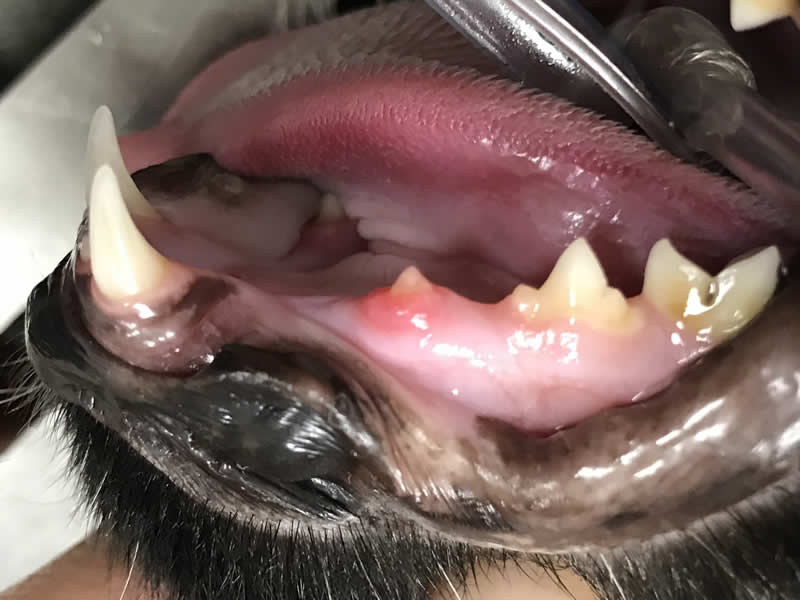Dental hygiene
It is generally recognised in clinical practice that between 70-80% of cats and dogs over three years old will have some dental disease.

The visible tooth with mild signs of gingivitis
Over time, debris, bacteria and inflammatory cells build up on the teeth to form plaque which, if not removed, will become mineralised to the hardened substance known as tartar or dental calculus.
This in turn, can cause inflammation of the gums know as gingivitis, and may lead to periodontal disease which can cause loosening of the teeth in their sockets. Ultimately, dental disease can leave pets with sore, smelly and painful mouths and may cause them to be unwell.
Once a vet or nurse has examined your pet, and recommended a dental, then it can be booked in for a dental procedure under a general anaesthetic.
During the dental procedure, the tartar will be gently removed from the surfaces of the teeth with special instruments and an ultrasonic descaler.
The teeth will be checked for chips, areas of damage and for security within their sockets. At Bicester Vets we routinely x-ray all cats teeth at this stage as disease can occur under the surface. In dogs we will x-ray any teeth which the vet is concerned about.

X-ray showing that the crown & roots are disintegrating below the surface
The x-rays will help to guide the vet about the need for any extractions, which are often performed surgically and the wound closed using very fine, dissolving sutures.
Remaining teeth will then be polished. This is to smooth any microscopic scratches that are left in the surface of the enamel, and help to slow down the future accumulation of plaque and tartar.
The dental work will then be recorded on a chart and attached to the patient’s clinical records. Depending on the procedure, your pet may also be given extra pain relief and/or a course of antibiotics.
When your pet has recovered from the anaesthetic, a nurse will discharge your pet and book a follow-up appointment, usually about a week later to ensure that the mouth is comfortable, that your pet is eating normally and that any extraction sites have properly healed.
This is also when you will be given advice on home dental care.
It is known that plaque can start to build up on the tooth surfaces very quickly even after a dental has been performed, and tooth brushing is the most effective way of minimising the accumulation of dental deposits.
Pets should be introduced to this process slowly, using a soft toothbrush, and toothpaste formulated especially for pets. The toothbrush should be used in a gentle circular motion around the area where the tooth meets the gum.
To supplement home dental care regimes, there are specialised veterinary diets, chews, pastes, gels and granules available to buy from Bicester Vets – all of which help to decrease the accumulation of plaque on the teeth.
We will do our best to accommodate your busy schedule
Please note that you do not have an appointment until you receive confirmation from us. Thank you


